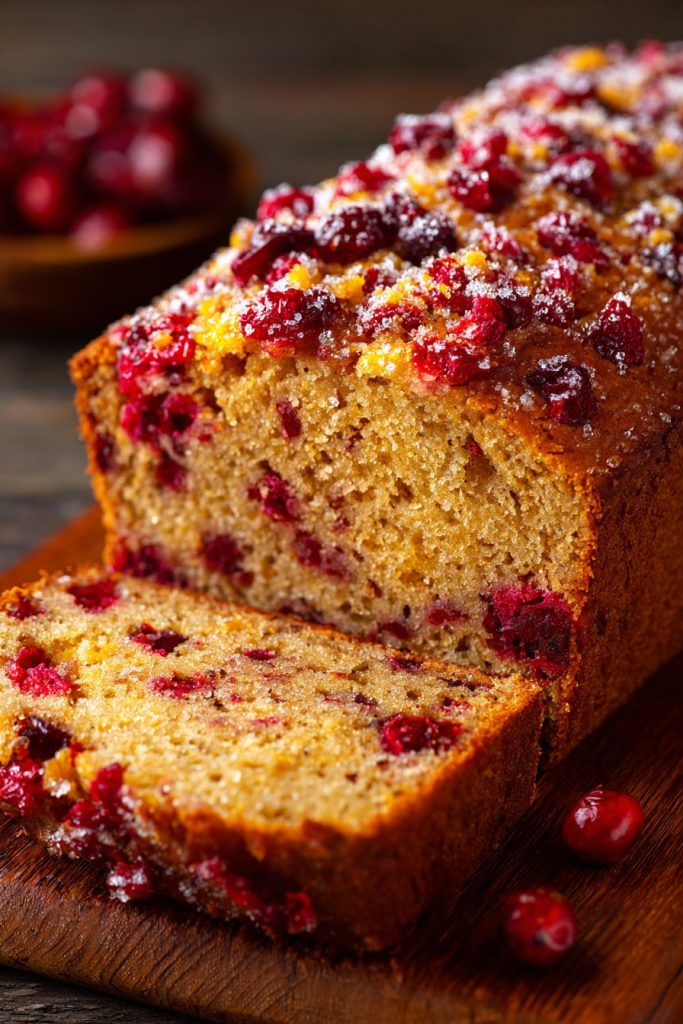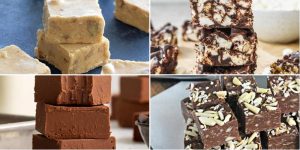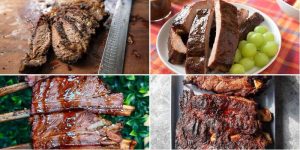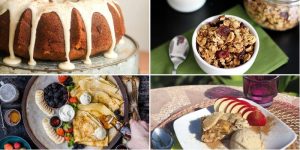Now that autumn’s crisp air has settled in, our bodies crave warming, nutrient-dense foods that support immune function during seasonal transitions. Naturally sweetened with honey and bursting with antioxidant-rich cranberries, this loaf provides sustained energy without the blood sugar spikes associated with refined sugars. The combination of whole wheat flour and Greek yogurt delivers both fiber and protein, making this an ideal breakfast or snack for maintaining stable energy levels throughout your busy day.
Why This Recipe Works
- The strategic combination of whole wheat pastry flour and all-purpose flour creates a tender crumb while maintaining structural integrity, providing more fiber and nutrients than traditional all-white flour loaves without compromising texture
- Fresh orange zest and juice deliver vibrant citrus notes while contributing vitamin C and flavonoids that support collagen production and immune health, creating a naturally bright flavor profile that reduces the need for excessive sweeteners
- Greek yogurt adds moisture and protein while activating baking soda for optimal rise, creating a dairy-based probiotic boost that supports gut health and nutrient absorption throughout the digestive process
- Turbinado sugar sprinkled on top creates a delicate crunch and caramelized crust while using minimal added sweetener, providing textural contrast that satisfies sweet cravings without overwhelming the natural tartness of cranberries
- Soaking dried cranberries in orange juice before baking plumps them with natural citrus flavors and prevents them from drying out during the baking process, ensuring every bite contains juicy, flavor-infused fruit bursts
Ingredients
- 1 cup whole wheat pastry flour
- 1 cup all-purpose flour
- 1 ½ teaspoons baking powder
- ½ teaspoon baking soda
- ¼ teaspoon salt
- 2 large eggs at room temperature
- ¾ cup plain Greek yogurt
- ½ cup honey
- ⅓ cup avocado oil
- Zest from 2 large oranges
- ¼ cup fresh orange juice
- 1 teaspoon vanilla extract
- 1 ¼ cups fresh cranberries, roughly chopped
- 2 tablespoons turbinado sugar for topping
Equipment Needed
- 9×5 inch loaf pan
- Parchment paper
- Medium and large mixing bowls
- Whisk
- Spatula
- Microplane or zester
- Citrus juicer
- Cooling rack
- Toothpick or cake tester
Instructions
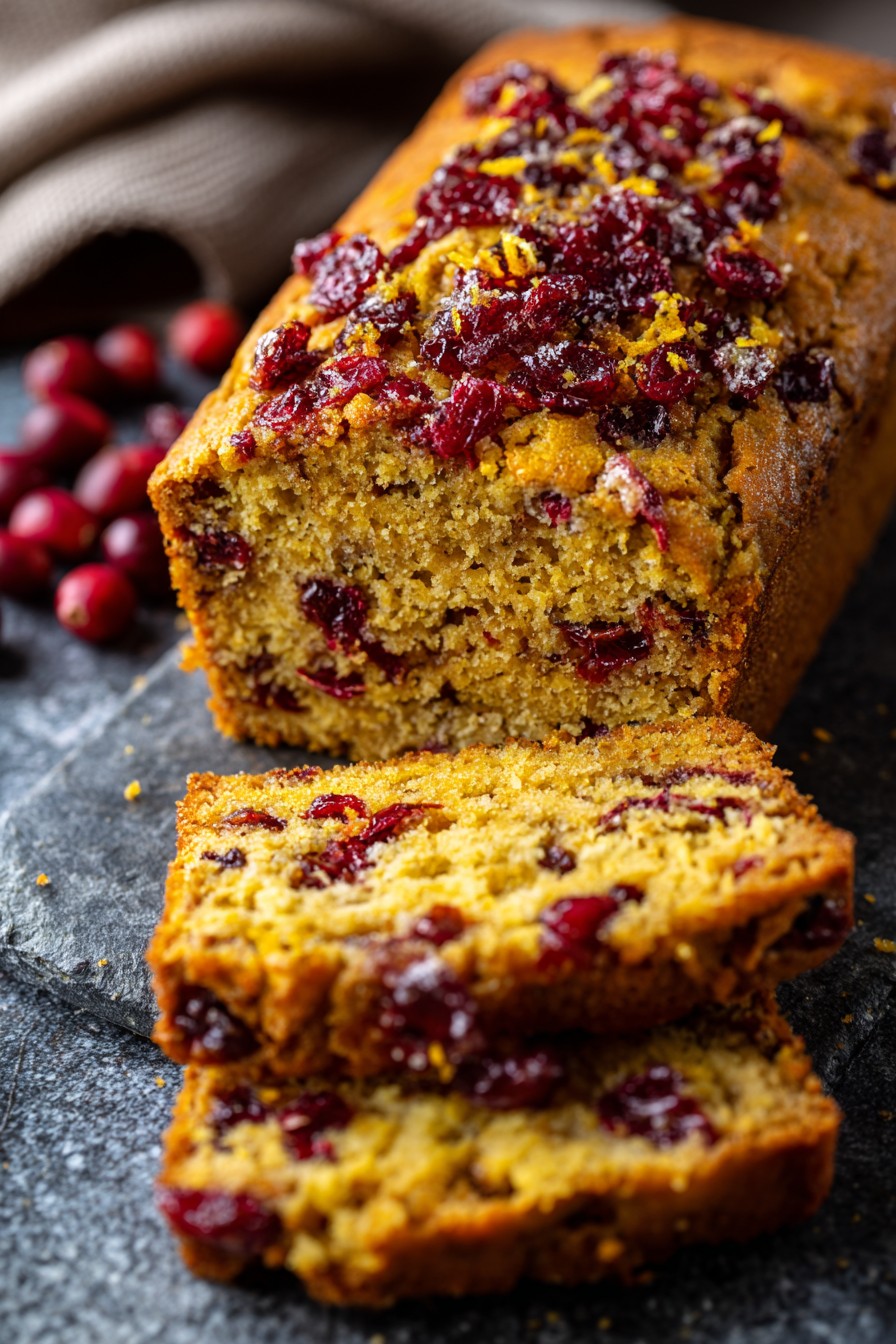
Prepare Your Ingredients and Pan
Begin by preheating your oven to 350°F and lining a 9×5 inch loaf pan with parchment paper, leaving some overhang on the sides for easy removal later. In a medium bowl, whisk together both flours, baking powder, baking soda, and salt until thoroughly combined and aerated—this dry mixture integration ensures even leavening distribution throughout your batter. Meanwhile, in your large mixing bowl, vigorously whisk the room-temperature eggs until pale and slightly frothy, about 45 seconds of continuous whisking. This initial egg aeration creates tiny air pockets that will expand during baking, contributing to a lighter final texture. Pro tip: Always bring eggs to room temperature by placing them in warm water for 10 minutes if forgotten, as cold eggs can cause your batter to seize and result in uneven baking.
Combine Wet Ingredients and Incorporate Flavors
Add the Greek yogurt, honey, avocado oil, orange zest, fresh orange juice, and vanilla extract to your whisked eggs, then mix vigorously for 60-75 seconds until the mixture becomes smooth, slightly thickened, and fully emulsified. The honey should be completely incorporated without any separation from the oil—this emulsion is crucial for uniform moisture distribution during baking. The orange zest should be visibly distributed throughout the mixture, releasing its essential oils that carry the most potent citrus flavor compounds. At this stage, the batter should appear creamy and homogeneous with tiny bubbles visible from your whisking action. This thorough wet ingredient combination ensures that the leavening agents will react consistently when mixed with dry ingredients, preventing uneven rising or dense spots in your finished loaf.
Gradually Incorporate Dry Ingredients
Add your pre-mixed dry ingredients to the wet mixture in three separate additions, using a spatula to gently fold after each addition until just combined—do not overmix at this critical stage. Stop folding when you no longer see dry flour pockets, even if the batter appears slightly lumpy; overmixing develops gluten strands that can create a tough, dense texture rather than the desired tender crumb. The batter should be thick but still pourable, with visible streaks of flour disappearing as you complete the final folds. This gentle incorporation method preserves the air bubbles you created during wet ingredient mixing while ensuring even hydration of all flour particles. Proper technique here makes the difference between a light, cake-like loaf and a heavy, bread-like texture.
Fold in Cranberries and Final Preparation
Gently fold the roughly chopped fresh cranberries into your batter using just 8-10 folding motions to distribute them evenly while preventing berry breakdown that could stain your batter pink. The cranberries should remain largely intact to provide bright tart bursts against the sweet citrus background. Transfer the completed batter to your prepared loaf pan, using your spatula to spread it evenly into all corners and create a slight dome in the center—this helps prevent a sunken middle during baking. Sprinkle the turbinado sugar evenly across the surface, which will create a delicate, crackly crust as it caramelizes during baking. Pro tip: Roughly chopping cranberries rather than using them whole ensures better distribution and prevents large air pockets from forming around whole berries during baking.
Bake to Perfection with Visual and Temperature Cues
Place your loaf pan in the center of the preheated 350°F oven and bake for 50-60 minutes, rotating the pan halfway through to ensure even browning. Begin checking for doneness at 50 minutes by inserting a toothpick into the center—it should emerge with just a few moist crumbs attached, not wet batter. The loaf should be deeply golden brown on top and pulling away slightly from the pan edges, with an internal temperature reading of 200-205°F when measured with an instant-read thermometer. The surface should spring back slowly when gently pressed rather than leaving an indentation. These multiple doneness indicators ensure your loaf is fully cooked without becoming dry—the temperature test is particularly reliable for avoiding underbaked centers that can collapse during cooling.
Cool Properly for Optimal Texture and Flavor Development
Remove the loaf from the oven and let it cool in the pan on a wire rack for exactly 15 minutes—this allows the structure to set sufficiently for handling while still warm enough to release cleanly from the pan. Using the parchment paper overhang, carefully lift the loaf from the pan and transfer it directly to the cooling rack, removing the parchment paper to allow air circulation on all surfaces. Cool completely for 2-3 hours before slicing; this patience allows the crumb structure to fully set and flavors to meld properly. Slicing while warm causes crumbling and compressed texture, while proper cooling ensures clean slices and optimal mouthfeel. Pro tip: The flavor actually improves after several hours as the citrus oils distribute more evenly throughout the loaf, making this an ideal make-ahead option.
Tips and Tricks
For those seeking to elevate their baking technique, several advanced approaches can enhance both nutrition and flavor profiles. When selecting cranberries, opt for the deepest red berries you can find, as they contain higher concentrations of anthocyanins—the powerful antioxidants responsible for their vibrant color and anti-inflammatory properties. If using frozen cranberries, do not thaw them before incorporating into your batter, as the excess moisture from thawing can create soggy spots and uneven baking; instead, toss them directly from the freezer with a tablespoon of your measured flour before folding in to prevent sinking. For maximum citrus flavor extraction, zest your oranges directly over your mixing bowl to capture every drop of the essential oils that release during zesting—these oils carry the most potent aromatic compounds. When measuring flour, use the spoon-and-level method rather than scooping directly from the bag to avoid compacting too much flour into your cup, which can lead to dry, dense results. For an extra nutritional boost, replace up to 2 tablespoons of the all-purpose flour with ground flaxseed or chia seeds, which add omega-3 fatty acids and additional fiber without significantly altering texture. If your oven tends to run hot, place an oven thermometer inside to verify the actual temperature, as even a 25-degree variance can significantly impact baking time and texture development. For optimal storage, wrap the completely cooled loaf in beeswax wrap or parchment paper before placing in an airtight container at room temperature—this maintains the ideal moisture level without creating condensation that could make the crust soggy. The loaf actually freezes exceptionally well; slice it before freezing and place parchment between slices for easy individual portion retrieval, then toast frozen slices directly for a quick, nutritious breakfast option that tastes freshly baked.
Recipe Variations
- For a gluten-free adaptation, replace both flours with 1 ¾ cups almond flour and ¼ cup tapioca flour, adding an extra egg to maintain structure and moisture—this version provides additional protein and healthy fats while creating a denser, more moist crumb that pairs beautifully with the tart cranberries
- Create a vegan version by substituting the eggs with flax eggs (2 tablespoons ground flaxseed mixed with 5 tablespoons water, rested for 10 minutes) and replacing Greek yogurt with an equal amount of coconut yogurt—this dairy-free alternative still delivers excellent rise and moisture while adding beneficial medium-chain triglycerides from coconut
- Enhance the antioxidant profile by adding ½ cup chopped walnuts or pecans along with the cranberries—the healthy fats in nuts help increase absorption of the fat-soluble vitamins present in the whole wheat flour while adding satisfying crunch and additional protein
- Transform this into a holiday breakfast bread by adding 1 teaspoon of cinnamon and ¼ teaspoon of nutmeg to the dry ingredients—these warming spices not only complement the citrus notes but also provide additional anti-inflammatory compounds that support digestive health during rich holiday meals
- For a lower-glycemic option, replace the honey with pure maple syrup and reduce the amount to ⅓ cup—maple syrup contains beneficial minerals like zinc and manganese and has a slightly lower glycemic impact while still providing the necessary liquid content for proper batter consistency
Frequently Asked Questions
Can I use dried cranberries instead of fresh in this recipe?
While fresh cranberries provide superior texture and tartness, dried cranberries can be substituted with proper preparation. Soak ¾ cup of unsweetened dried cranberries in the orange juice called for in the recipe for 20-30 minutes until plumped, then drain and reserve the juice for the wet ingredients. This rehydration process prevents the dried berries from absorbing too much moisture from your batter during baking, which could result in a dry loaf. Be aware that most commercial dried cranberries contain added sugars, so opt for unsweetened varieties to maintain the nutritional integrity of this recipe. The resulting loaf will be sweeter and less tart than the fresh cranberry version, with a chewier fruit texture throughout.
What’s the purpose of using both baking powder and baking soda?
This dual-leavening approach creates a perfectly risen loaf with fine, even crumb structure. Baking powder provides the initial rise when mixed with liquid ingredients and continues working during the early baking stage as the batter heats. Baking soda requires an acidic component to activate—in this recipe, the Greek yogurt and orange juice provide that acidity—and creates additional lift while helping neutralize acids for balanced flavor. The combination ensures your loaf rises steadily without collapsing, while the baking soda particularly enhances browning for that beautiful golden crust. Using both leavenings in proper proportion prevents the metallic aftertaste that can occur with excessive baking soda while maximizing rise potential.
Can I make this recipe dairy-free while maintaining moisture?
Absolutely—replace the Greek yogurt with an equal amount of dairy-free yogurt alternatives, with coconut yogurt providing the best results due to its similar thickness and fat content. For additional insurance against dryness, increase the avocado oil by one tablespoon and consider adding one extra tablespoon of orange juice. The proteins in Greek yogurt do contribute to structure, so the dairy-free version may be slightly more delicate, but still delicious. Another option is using ½ cup applesauce mixed with ¼ cup coconut cream, which provides both moisture and some structural support while adding natural sweetness that complements the cranberries beautifully.
How can I tell if my loaf is perfectly baked without overbaking?
Employ multiple testing methods for certainty: the toothpick test should show moist crumbs rather than wet batter, the internal temperature should register 200-205°F on an instant-read thermometer, the top should be springy to touch rather than leaving an indentation, and the edges will visibly pull away from the pan sides. The most reliable indicator is actually the temperature test, as visual cues can be misleading depending on your oven’s heating patterns. If your loaf is browning too quickly before the center is done, tent it loosely with aluminum foil after 40 minutes of baking to prevent over-browning while the interior continues cooking properly.
Why does the recipe specify room temperature eggs and what if I forget?
Room temperature eggs incorporate more air when whisked and blend more seamlessly with other ingredients, creating a smoother, more homogeneous batter that rises consistently. Cold eggs can cause the batter to seize, particularly when combined with honey, which thickens when chilled. If you’ve forgotten to bring eggs to room temperature, place them in a bowl of warm (not hot) water for 10-12 minutes before using. Alternatively, you can whisk the eggs alone over a double boiler for 15-20 seconds while constantly stirring until they lose their chill—this gentle warming technique prevents accidentally cooking the eggs while achieving the temperature needed for optimal emulsion with your other wet ingredients.
Summary
This orange cranberry loaf combines whole grains, fresh fruit, and natural sweeteners for a nutrient-dense baked good that satisfies sweet cravings while supporting overall health. The strategic ingredient selection provides fiber, antioxidants, and sustained energy perfect for busy mornings or afternoon slumps. With proper technique and the variations provided, this versatile recipe adapts to numerous dietary preferences while maintaining exceptional flavor and texture.
Orange Cranberry Loaf
6
servings20
minutes55
minutesIngredients
Instructions
- 1 Preheat oven to 350°F and line 9x5 inch loaf pan with parchment paper
- 2 Whisk flours, baking powder, baking soda, and salt in medium bowl
- 3 In large bowl, whisk eggs until frothy, then add yogurt, honey, oil, zest, juice, and vanilla
- 4 Gradually fold dry ingredients into wet until just combined
- 5 Gently fold in cranberries, transfer to pan, and sprinkle with turbinado sugar
- 6 Bake 50-60 minutes until golden and toothpick comes out clean
- 7 Cool in pan 15 minutes, then transfer to rack to cool completely
